Use of PVDF Wire Sensors for Leakage Localization in a Fluid-Filled Pipe
Abstract
1. Introduction
2. Methodology
2.1. Overview of Leak Noise Propagation in a Fluid-Filled Pipe
2.2. Piezoelectric Property of the PVDF Wire Sensor
2.3. Pipe Leakage Localization
3. Experimental Setup and Procedure
3.1 The Experimental Rig
3.2 Leak Noise Measurements
4. Data Analysis
4.1. Pressure Sensitivity of PVDF Wire Sensors
4.2. Leak Localization
4.2.1. In-Air Case
4.2.2. In-Water Case
5. Conclusions
Author Contributions
Acknowledgments
Conflicts of Interest
References
- Ministry of Housing and Urban-Rural Development of the People’s Republic of China (MOHURD). Available online: http://www.mohurd.gov.cn/wjfb/201710/t20171023_233687.html (accessed on 25 December 2019).
- What is Non-revenue Water? How Can We Reduce it for Better Water Service? Available online: http://blogs.worldbank.org/water/what-non-revenue-water-how-can-we-reduce-it-better-water-service (accessed on 25 December 2019).
- The Challenge of Reducing Non-Revenue Water (NRW) in Developing Countries - How the Private Sector Can Help: A Look at Performance-based Service Contracting. Available online: http://documents.vsemirnyjbank.org/curated/ru/385761468330326484/The-challenge-of-reducing-non-revenue-water-NRW-in-developing-countries-how-the-private-sector-can-help-a-look-at-performance-based-service-contracting (accessed on 25 December 2019).
- Cao, X.; Ruan, C. Compilation of investigation on water loss rate of water supply pipelines in global major cities. Water Purification Teochnwledge 2017, 36, 6–14. [Google Scholar]
- Hiroki, S.; Tanzawa, S.; Arai, T.; Abe, T. Development of water leak detection method in fusion reactors using water-soluble gas. Fusion Eng. Des. 2008, 83, 72–78. [Google Scholar] [CrossRef]
- Eidenshink, J.C. Detection of leaks in buried rural water pipelines using thermal infrared images. Photogramm. Eng. Remote Sens. 1985, 51, 561–564. [Google Scholar]
- Hunaidi, O.; Giamou, P. Ground-penetrating radar for detection of leaks in buried plastic water distribution pipes. In Proceedings of the 7th International Conference on Ground Penetrating Radar, Lawrence, KS, USA, 27–30 May 1998. [Google Scholar]
- Dimitrics, M.C.; Kamal, Y.T.; Atia, E.K.; Rached, B.M. Analysis and design of an in-pipe system for water leak detection. In Proceedings of the ASME 2011 International Engineering Technical Conferences & Computers and Information in Engineering Conference, Washington, DC, USA, 28–31 August 2011; pp. 1007–1016. [Google Scholar]
- Fuchs, H.V.; Riehle, R. Ten years of experience with leak detection by acoustic signal analysis. Appl. Acoust. 1991, 33, 1–19. [Google Scholar] [CrossRef]
- Puust, R.; Kapelan, Z.; Savic, D.; Koppel, T. A review of methods for leakage management in pipe networks. Urban Water J. 2010, 7, 25–45. [Google Scholar] [CrossRef]
- Li, R.; Huang, H.; Xin, K.; Tao, T. A review of methods for burst/leakage detection and location in water distribution systems. Water Sci. Tech-W. Sup. 2015, 15, 429–441. [Google Scholar] [CrossRef]
- Gao, Y.; Brennan, M.J.; Joseph, P.F.; Muggleton, J.M.; Hunaidi, O. On the selection of acoustic/vibration sensors for leak detection in plastic water pipes. J. Sound Vib. 2005, 283, 927–941. [Google Scholar] [CrossRef]
- Ma, Y.; Gao, Y.; Brenan, M.J.; Cui, X.; Yang, J. Adaptive phase transform method for pipeline leakage detection. Sensors 2019, 19, 310. [Google Scholar] [CrossRef]
- Gao, Y.; Brennan, M.J.; Joseph, P.F.; Muggleton, J.M.; Hunaidi, O. A model of the correlation function of leak noise in buried plastic pipes. J. Sound Vib. 2004, 277, 133–148. [Google Scholar] [CrossRef]
- Gao, Y.; Brennan, M.J.; Joseph, P.F. A comparison of time delay estimators for the detection of leak noise signals in plastic water distribution pipes. J. Sound Vib. 2006, 292, 552–570. [Google Scholar] [CrossRef]
- Duan, H.F.; Lee, P.J.; Ghidaoui, M.S.; Tung, Y.K. System response function-based leak detection in viscoelastic pipelines. J. Hydraul. Eng. 2012, 138, 143–153. [Google Scholar] [CrossRef]
- Bracken, M.; Johnson, D. Transmission main and plastic pipe leak detection using advanced correlation technology: Case study. In Proceedings of the Pipelines Conference 2012, Seattle, DC, USA, 23–27 July 2011; pp. 147–157. [Google Scholar]
- Martini, A.; Troncossi, M.; Rivola, A. Leak detection in water-filled small-diameter polyethylene pipes by means of acoustic emission measurements. Appl. Sci. 2017, 7, 2. [Google Scholar] [CrossRef]
- Martini, A.; Rivola, A.; Troncossi, M. Autocorrelation analysis of vibro-acoustic signals measured in a test field for water leak detection. Appl. Sci. 2018, 8, 2450. [Google Scholar] [CrossRef]
- Liu, Y.; Ma, X.; Li, Y.; Tie, Y.; Zhang, Y.; Gao, J. Water pipeline leakage detection based on machine learning and wireless sensor network. Sensors 2019, 19, 5086. [Google Scholar] [CrossRef]
- Yazdekhasti, S.; Piratla, K.R.; Sorber, J.; Atamturktur, S.; Khan, A.; Shukla, H. Sustainability analysis of a leakage-monitoring technique for water pipeline network. J. Pipeline Syst. Eng. Pract. 2020, 11, 04019052. [Google Scholar] [CrossRef]
- Xu, J.; Chai, K.T.C.; Wu, G.; Han, B.; Wai, E.L.C.; Li, W.; Yeo, J.; Nijhof, E.; Gu, Y. Low-cost, tiny-sized MEMS hydrophone sensor for water pipeline leak detection. IEEE Trans. Ind. Electron. 2019, 66, 6374–6382. [Google Scholar] [CrossRef]
- Kaiwai, H.J. The piezoelectricity of poly(vinylidene fluoride). Jpn. J. Appl. Phys. 1969, 8, 975–976. [Google Scholar] [CrossRef]
- Li, Q.; Xing, J.; Shang, D.; Wang, Y. A flow velocity measurement method based on a PVDF piezoelectric sensor. Sensors 2019, 19, 1657. [Google Scholar] [CrossRef]
- Richetts, D. Electroacoustic sensitivity of composite piezoelectric polymer cylinders. Journal of the Acoustical J. Acoust. Soc. Am. 1980, 68, 1025–1029. [Google Scholar] [CrossRef]
- David, R.F. A low-density extended acoustic sensor for low-frequency arrays. IEEE J. Ocean. Eng. 1988, 13, 291–295. [Google Scholar]
- Gao, Y.; Sui, F.; Muggleton, J.M.; Yang, J. Simplified dispersion relationships for fluid-dominated axisymmetric wave motion in buried fluid-filled pipes. J. Sound Vib. 2016, 375, 386–402. [Google Scholar] [CrossRef]
- Gao, Y.; Liu, Y.; Muggleton, J.M. Axisymmetric fluid-dominated wave in fluid-filled plastic pipes: Loading effects of surrounding elastic medium. Appl. Acoust. 2017, 116, 43–49. [Google Scholar] [CrossRef]
- Pinnington, R.J.; Briscoe, A.R. Externally applied sensor for axisymmetric waves in a fluid filled pipe. J. Sound Vib. 1994, 173, 503–516. [Google Scholar] [CrossRef]
- Fuller, C.R.; Fahy, F.J. Characteristic of wave propagation and energy distributions in cylindrical elastic shells filled with fluid. J. Sound Vib. 1982, 81, 501–518. [Google Scholar] [CrossRef]
- Tasala, S.; Miyata, S. The origin of piezoelectricity in poly(vinylindene Fluoride). Ferroelectrics 1981, 32, 17–23. [Google Scholar]
- Nakamura, K.; Wada, Y. Piezoelectricity, pyroelectricity, and the electrostriction constant of Poly(vinylindene Fluoride). J. Polym. Sci. A-2. Polym. Phys. 1971, 9, 161–173. [Google Scholar] [CrossRef]
- Ding, B.; Wu, X.; Han, X.; Chen, J.Y. Studies on sensing properties of PVDF piezoelectric films. In Proceedings of the 2017 Symposium on Piezoelectricity, Acoustic Waves, and Device Applications, Chengdu, China, 27–30 October 2017; pp. 155–158. [Google Scholar]
- Kowbel, W.; Xia, X.; Champion, W.; Withers, J.C.; Wada, B.K. PZT/polymer flexible composites for embedded actuator and sensor applications. In Smart Structures and Materials 1999: Smart Materials Technologies; SPIE: Newport Beach, CA, USA, 1999; Volume 3675, pp. 32–42. [Google Scholar]
- Liu, B.; Gao, Y.; Ma, Y.; Yang, J. Experimental investigation into acoustic characteristics of leakage signals from underwater plastic water-filled pipes. In Proceedings of the 24th International Congress on Sound and Vibration, London, UK, 23–27 July 2017. [Google Scholar]
- Almeida, F.C.; Brennan, M.J.; Joseph, P.F.; Dray, S.; Whitfield, S.; Paschoalini, A.T. Towards an in-situ measurement of wave velocity in buried plastic water distribution pipes for the purposes of leak location. J. Sound Vib. 2015, 359, 40–55. [Google Scholar] [CrossRef]
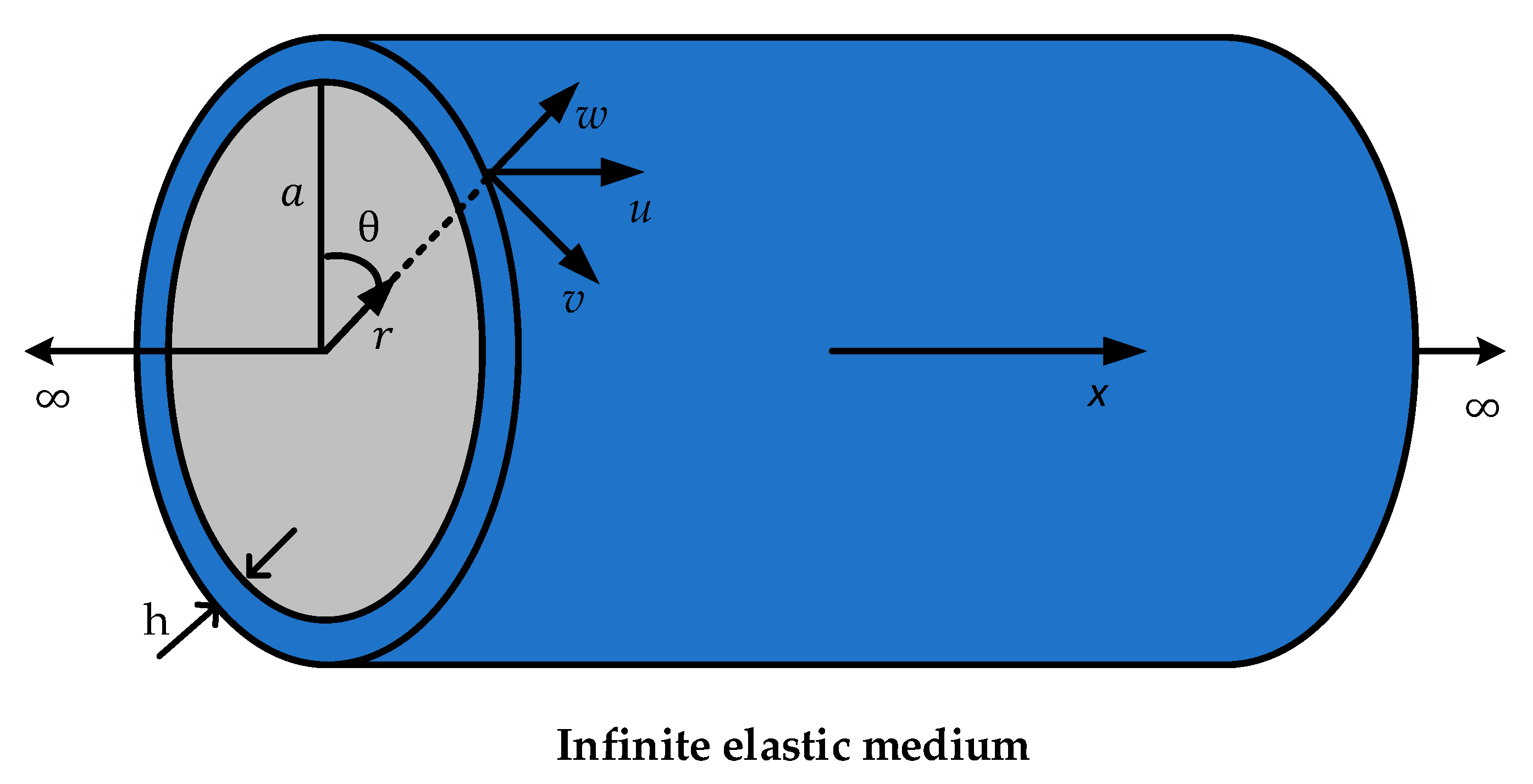
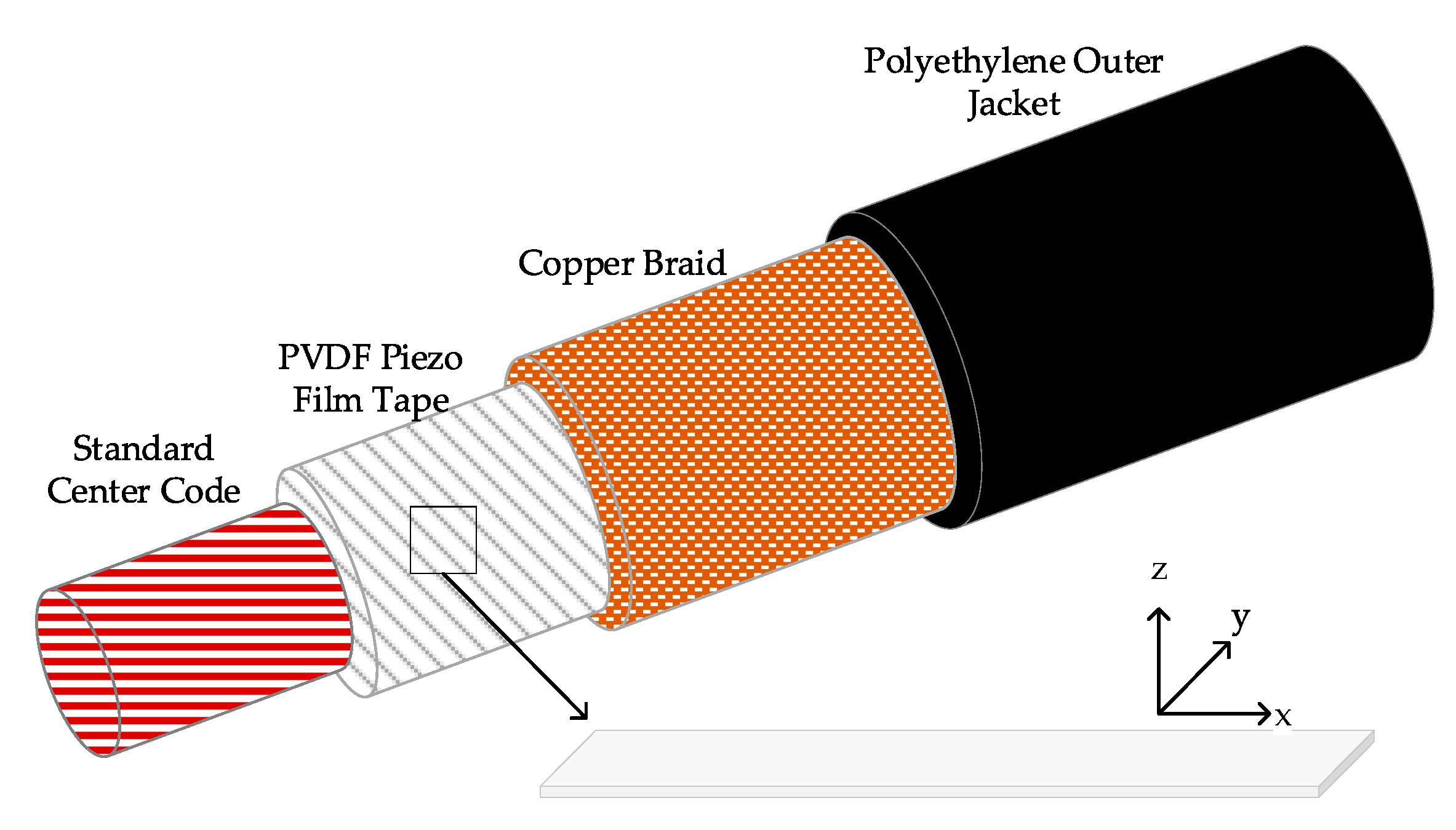
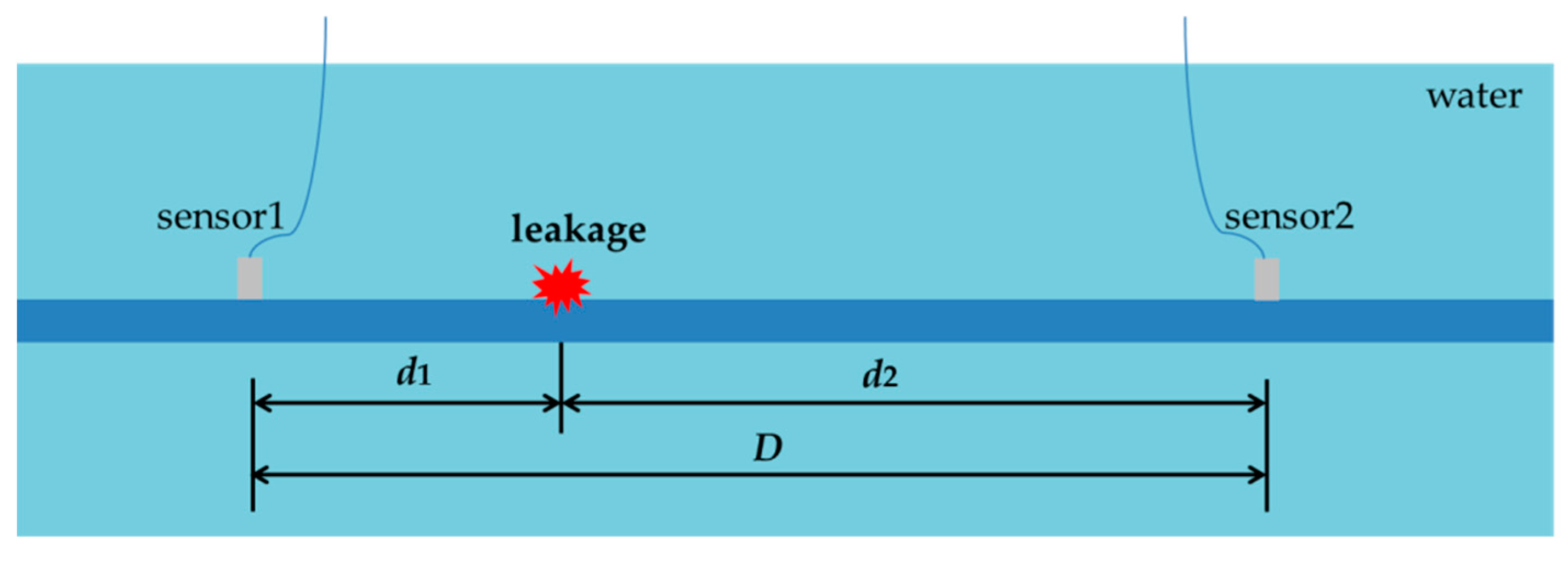
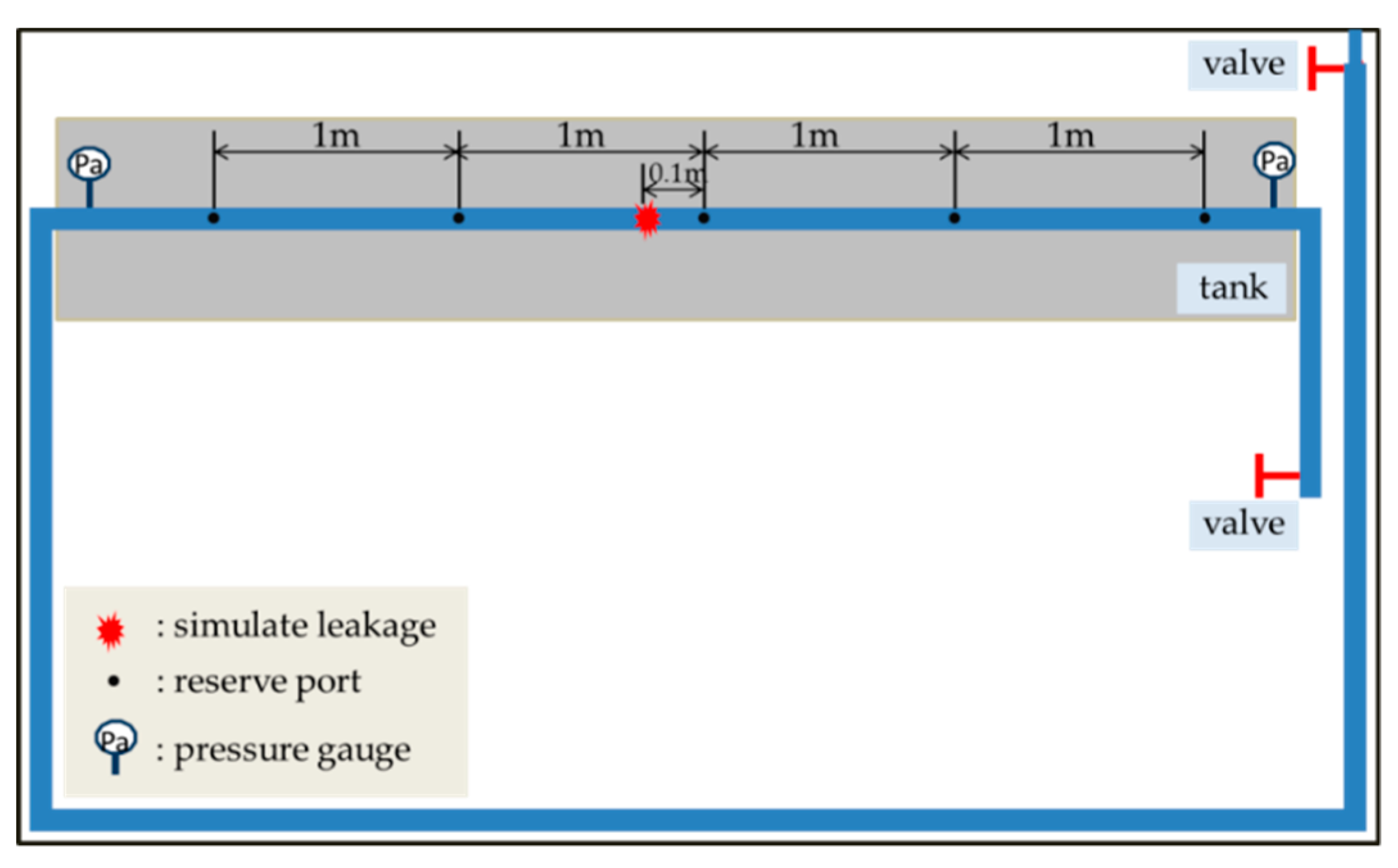

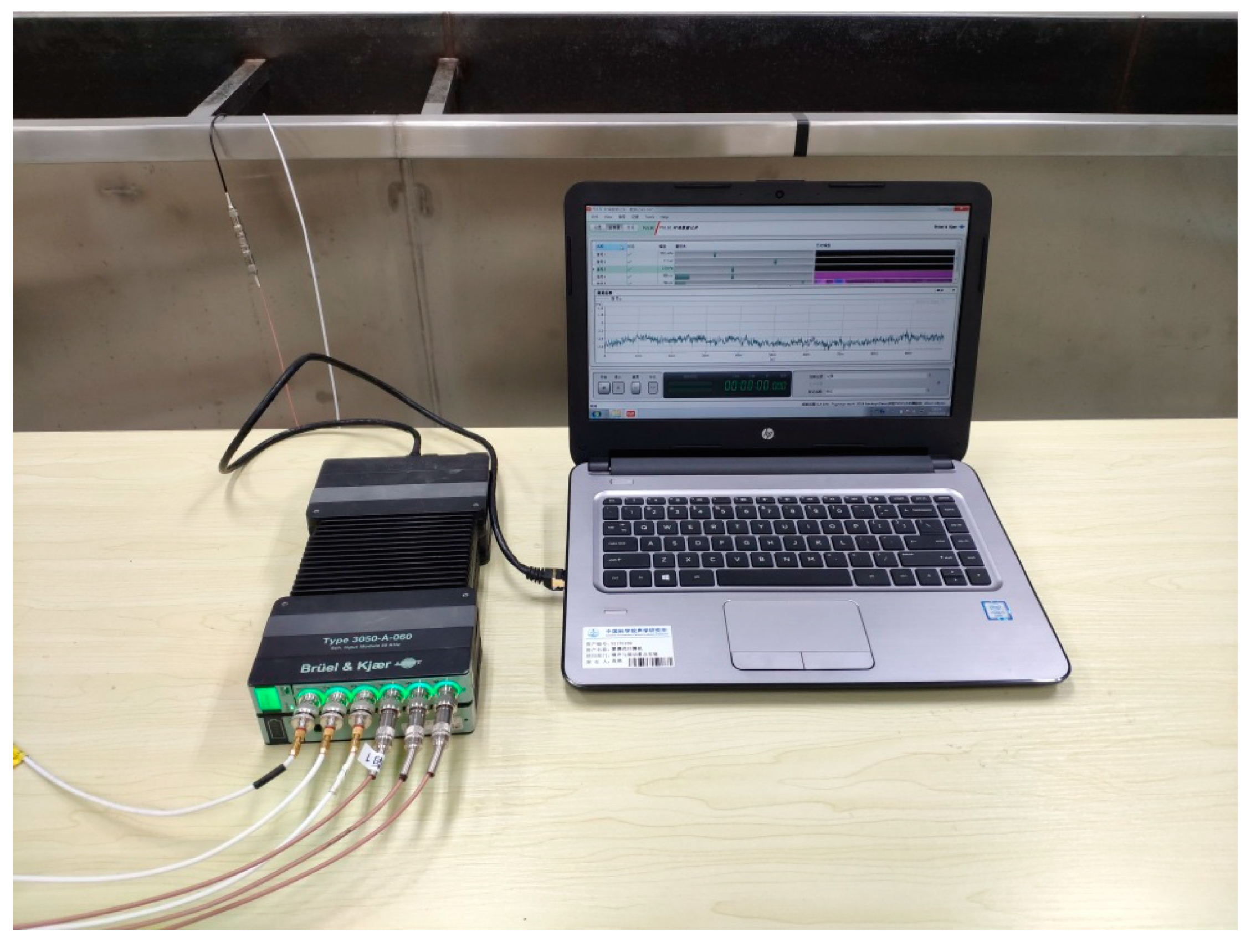

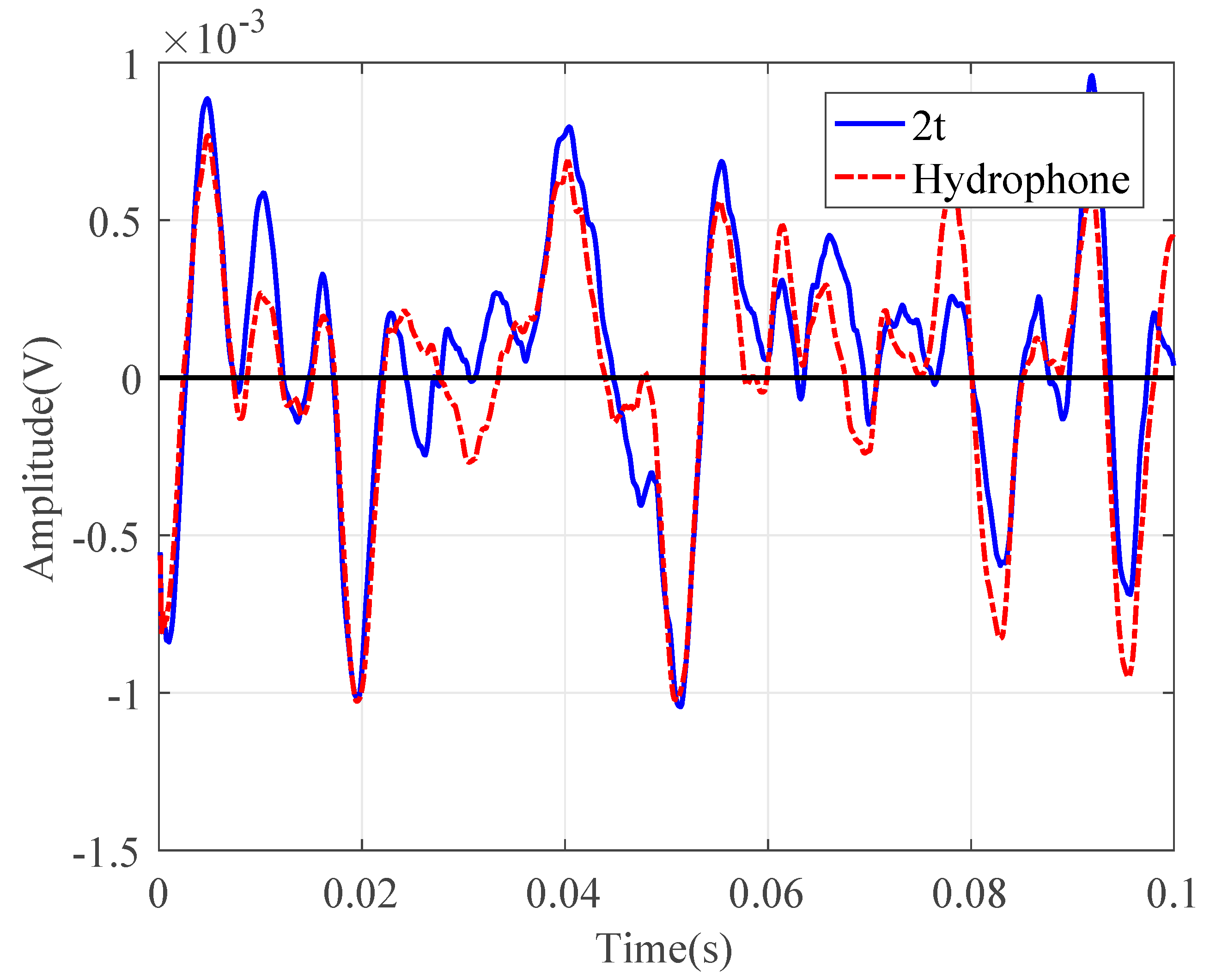

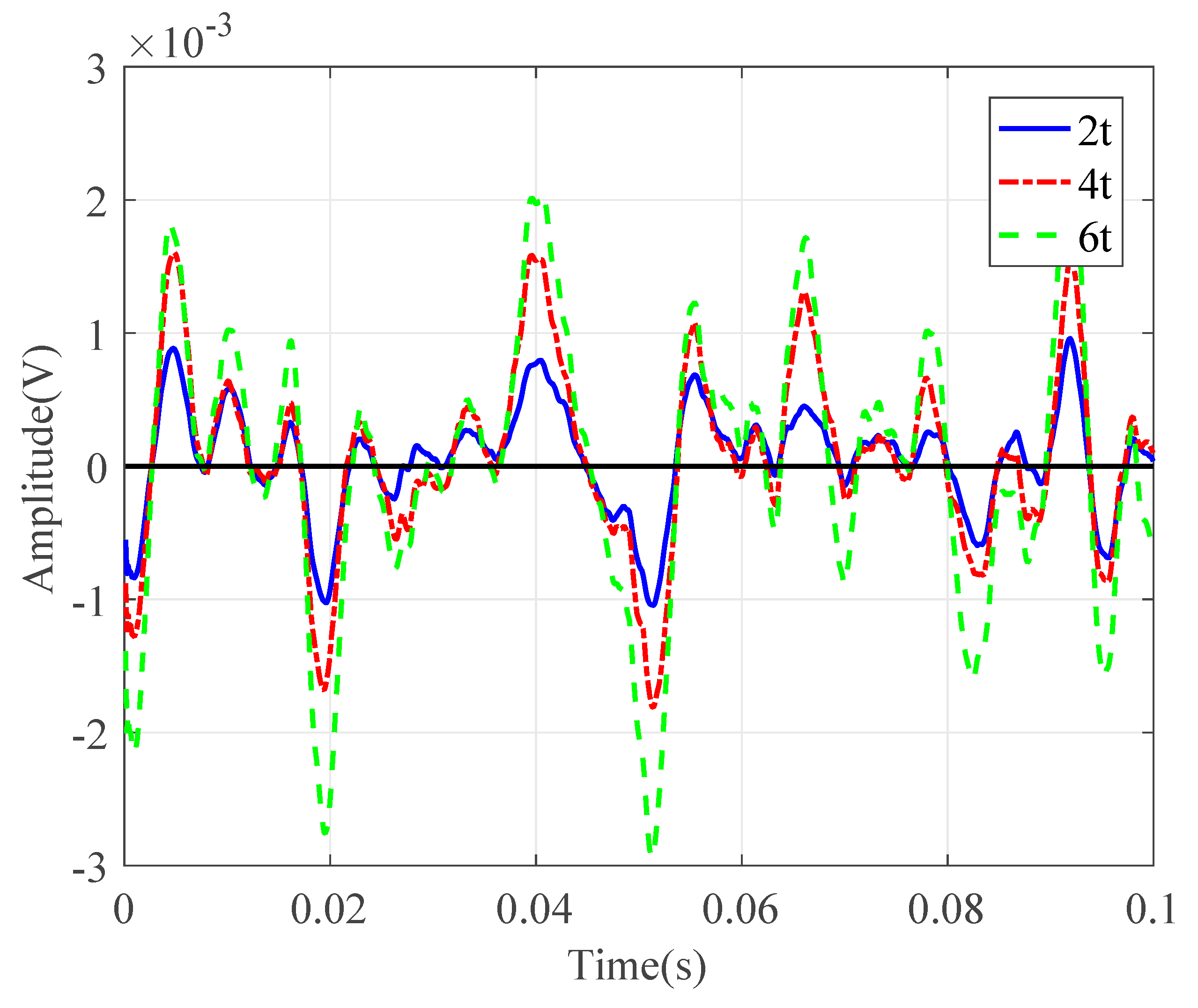


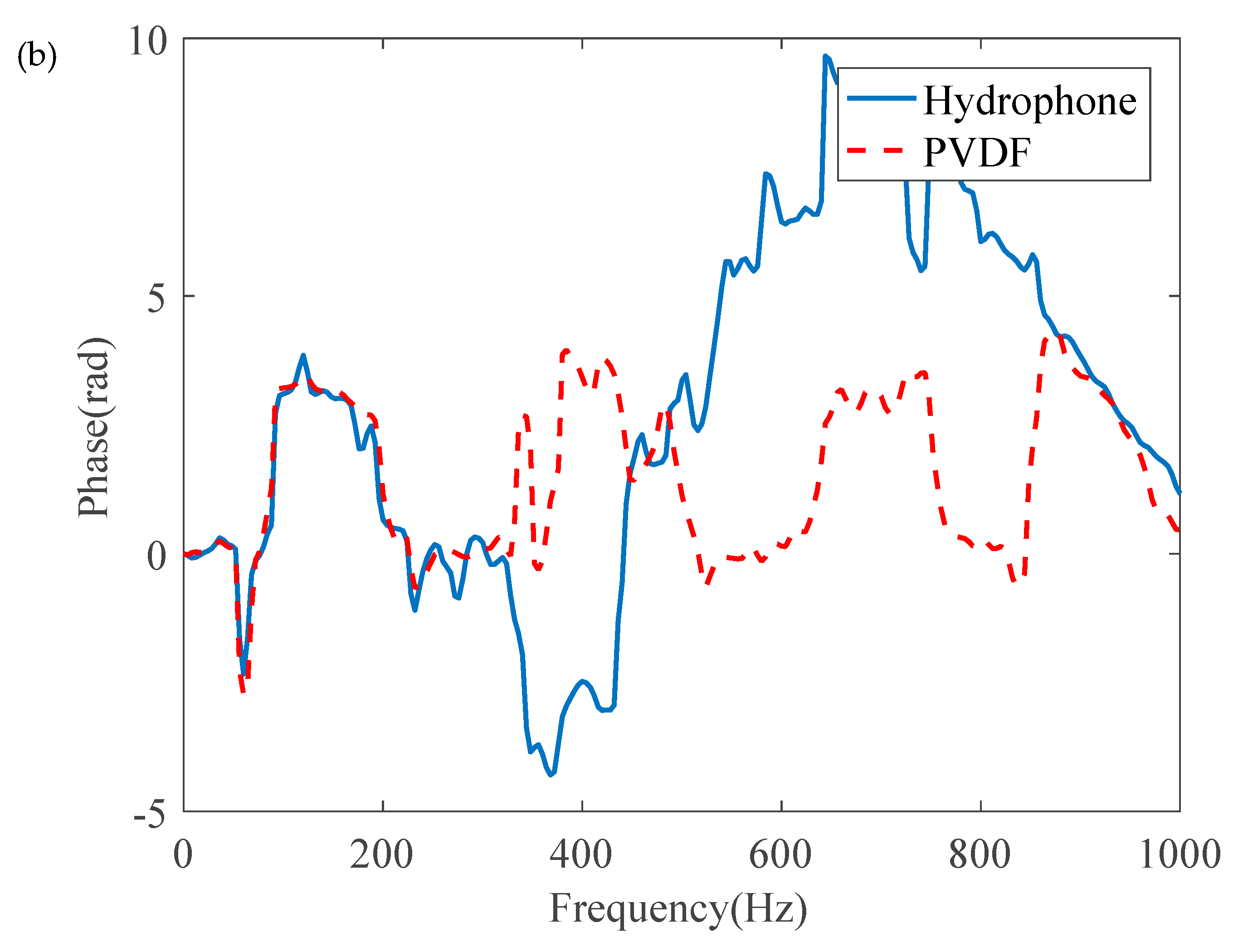



| Material | Cast Iron | PVC |
|---|---|---|
| Density () | 7100 | 2000 |
| Young’s Modulus () | 100 | 5 |
| Poisson’s Ratio | 0.29 | 0.4 |
| Radius (mm) | 50 | 50 |
| Thickness (mm) | 5 | 5 |
© 2020 by the authors. Licensee MDPI, Basel, Switzerland. This article is an open access article distributed under the terms and conditions of the Creative Commons Attribution (CC BY) license (http://creativecommons.org/licenses/by/4.0/).
Share and Cite
Sun, P.; Gao, Y.; Jin, B.; Brennan, M.J. Use of PVDF Wire Sensors for Leakage Localization in a Fluid-Filled Pipe. Sensors 2020, 20, 692. https://doi.org/10.3390/s20030692
Sun P, Gao Y, Jin B, Brennan MJ. Use of PVDF Wire Sensors for Leakage Localization in a Fluid-Filled Pipe. Sensors. 2020; 20(3):692. https://doi.org/10.3390/s20030692
Chicago/Turabian StyleSun, Pingling, Yan Gao, Boao Jin, and Michael J. Brennan. 2020. "Use of PVDF Wire Sensors for Leakage Localization in a Fluid-Filled Pipe" Sensors 20, no. 3: 692. https://doi.org/10.3390/s20030692
APA StyleSun, P., Gao, Y., Jin, B., & Brennan, M. J. (2020). Use of PVDF Wire Sensors for Leakage Localization in a Fluid-Filled Pipe. Sensors, 20(3), 692. https://doi.org/10.3390/s20030692





